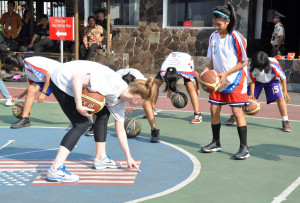What is Drill Progression?
Drill Progression should be about the linking of activities based on a specific ethos of progressive development. In a poor situation however, drill progression can be a haphazard journey that leads to extended timelines for development and progression of the individual. Planning and selecting the right types of drills to be linked together will lead to a smooth transition from one stage of development to another. Evolving the right ethos around drill progression will also lead to a more rounded knowledge by a coach in the area of technical and tactical growth for a coach.
To understand how to put together drill progression so it becomes a functional part of basketball coaching, a coach must examine the different technical skills involved in basketball. These skills can be found in many different skill lists or a skill matrix. The skills listed in these resources will cover aspects such as dribbling, shooting, individual defence and passing. However, additionally these lists should also include fundamental tactical aspects as well like the passing and cutting, screening and team defensive principles. A resource like a skill matrix will outline the fundamental technical and tactical skills, but it is not a document on the philosophy of teaching these skills, but an itemised list of them.

Once you have a list of fundamentals you can then start to link drills to each of the technical skills identified. Some drills will be able to be used for a variety of skills and can be modified to then cover different areas of need. There are still some aspects to keep in mind with regards to drill progression when building a coaches Drill Bank.
The first aspect to keep in mind is the range of skill level the drill will need to cover. The very first drill included into a coaches bank of drills for teach passing should be focused around the learning of the fundamental skill in a very controlled environment. It does not matter if a coach is at the elite level or a junior development coach, understanding the history of how a skill is mastered will assist in making the drill progression specific to the individual. With this in mind a coach must have a group of drills which meet a range of skill levels to be used in drill progression for all levels of player development.
The next aspect which needs to be considered in regards to drill progression is competition. When players are starting out in basketball they will need time to develop a technical skill in isolation of competition. This situation can also be true for an elite player if they are looking to develop or refine a new technical skill. Once a skill is improved past the initial stages of practicing the physiological movements, it must be then performed in a competitive situation. This helps the player learn how to utilise the skill in a functional way. For this reason when examining the bigger picture of drill progression different drills need to be selected that help with a focus on player development and others that add competition for the players ongoing advancement.
Another element that needs to be explore when looking at drill progression is the participate number involved in a drill. When a player is first starting out with learning a new skill they will benefit from being able to perform in a 1 v 0 situation. As their ability increases, they will move to 1 v 1 and the participate number involved in a drill should increase as the players become more competent. This is obvious for tactical skills that are based around a minimum of two players being involved, but the principle is also the same for technical skills. Allowing additional players to be involved in drills increases the difficulty and complexity to performing the skill.
Thinking about skill progression will help a coach in the selection drills and developing their drill bank. Keep in mind that some drills might not be used as often as others, the key is choosing the right drill to meet the specific needs of your players and team at the right time.







